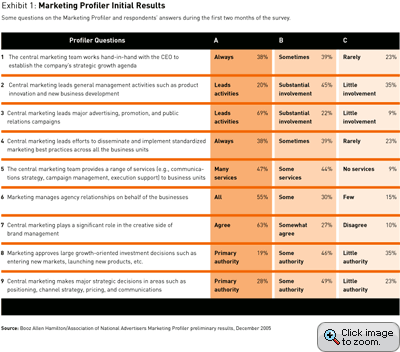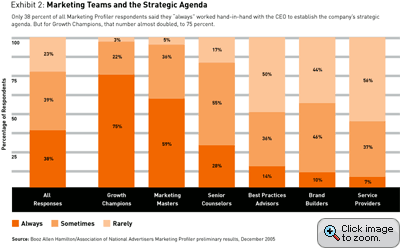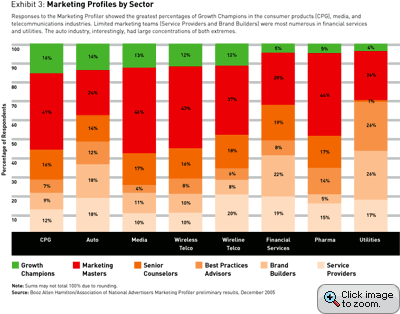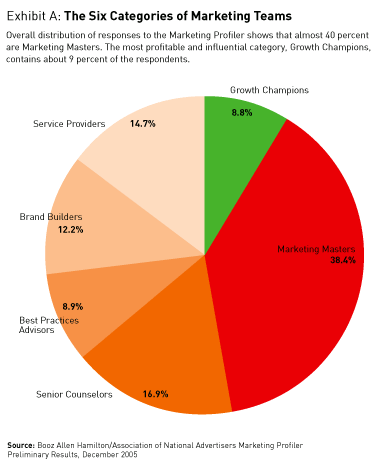Growth Champions
How to drive the only marketing metric that matters.
 |
|
Illustration by Seymour Chwast |
In late 2005 and early 2006, Booz Allen Hamilton and the Association of National Advertisers (ANA) surveyed 2,000 executives about the structure and practice of their companies’ marketing organizations. Marketing organizations, we found, broke down into six basic categories, each with its own orientation to its role within the company, its primary constituents, and its most important capabilities within the marketing domain. (For more about the six categories, and to consider which one your team might fit into, see “The Marketing Organization's DNA.”) But only one of the six organization types correlated clearly with better performance; teams in this category are 20 percent more likely to exhibit superior revenue growth and profitability for their industry than marketing departments in the other five categories.
We call these marketers Growth Champions. Although only 9 percent of the companies we surveyed have marketing departments that fall into this category, their traits and experiences suggest methods by which all marketers can increase their ability to generate superior results, no matter which type of organization they have today.
Unlike the other five categories, Growth Champions see themselves as “owners” of their company’s key growth-support functions, whether or not these fit into conventional definitions of marketing practice. The chief marketing officer (CMO or equivalent head) of a Growth Champion marketing department leads such general management activities as product innovation and new business development; he or she also approves large investment decisions to enter new markets or launch new products. In addition to their broader scope of responsibility, Growth Champions share several other significant characteristics:
-
They can identify their contributions to revenue growth, and they gain added authority from their ability to define return on investment (ROI).
-
Their members have a broader range of capabilities than their counterparts in other companies.
-
They use standardized tools and processes for efficiency.
-
They are proactive, not reactive, in providing both guidance and services that they believe add value to the senior leadership team.
-
They are perceived by other executives, especially C-suite officers, as contributors to and leaders of the growth agenda.
Though Growth Champions constitute a relatively small portion of the marketing universe, there are indications that more companies are advancing in this direction. Last year, for example, Coca-Cola Company announced it was eliminating the position of chief marketing officer and rolling marketing, innovation, and strategic growth leadership into a single corporate function. Coke followed Pepsi, Intel, IBM, Samsung, and other pioneers in explicitly linking the marketing function and the imperative for growth.
Leading the Business
The six types of marketing organizations fall into three broader pairs, related to the primary role the marketing department plays in the life and activities of the firm. The most traditional marketing teams, Service Providers and Brand Builders, specialize in delivering conventional marketing services to teams or the whole company, respectively. Best Practices Advisors and Senior Counselors play a more consultative role, adding advisory services to the mix of tactical support. Those in the final pair, Marketing Masters and Growth Champions, take active leadership roles in their companies. The Growth Champion CMO and the Marketing Master CMO are both members of the firm’s leadership team, for example.
But in scope of responsibility, authority, capabilities, and organizational linkages, Growth Champions differ markedly from the five other types. Growth Champion CMOs fit the profile of business leaders, not just marketing leaders. They direct strategic growth initiatives under the guidance of the CEO — a task that in other companies is frequently overseen by finance or sales. The members of Growth Champion teams also excel in general management skills. They move outside the limits to which most marketers consign themselves; by background and training, they appear to possess the analytic and leadership abilities that would allow them to work cross-functionally, and even transition into lead operating roles.
To understand the distinctive edge that Growth Champions hold, consider the role of the marketing department in the transformation of IBM. At the beginning of the 1990s, IBM’s glory days were far behind it. The company had failed to recognize that the computer market had changed and that hardware increasingly was a commodity. Its pricing power eroding, the company recorded $16 billion in losses between 1991 and 1993.
In 1994, IBM’s new chief executive, Louis Gerstner Jr., refocused the organization, beginning with an effort to listen more closely to its customers. The new intelligence gathered by IBM revealed that customers cared less about computer products than they did about solving enterprise-related IT problems. The resulting shift in IBM’s corporate identity — from product manufacturer to solutions provider — made possible the company’s dramatic recovery. Mr. Gerstner established IBM Global Services and tasked the organization with opening new channels that would enable information to flow among the various businesses so that comprehensive solutions packages could be developed.
By breaking down the silos that had existed across the business units, Mr. Gerstner enabled the development of a “brand-based” operational model, similar to that found in consumer packaged-goods companies. In this environment, collaboration among marketing and other functional areas drove brand and product development. Mr. Gerstner and his senior team then reorganized the sales force along industry lines, defined 14 industry sectors as critical for the company to dominate with solutions, and appointed leaders to spearhead initiatives in each sector. This new sales force brought to market bundled hardware, software, and service packages that could be sold at a premium. Ten years later, IBM is the world’s leading provider of technology services and solutions. The company is customer-focused and marketing-driven. IBM ranks third on Business Week’s 2005 list of the Top 100 Global Brands (after Coca-Cola and Microsoft).
IBM’s marketing organization was integral to the change that Mr. Gerstner drove, and represents much of what a Growth Champion marketing team should provide. Big Blue’s CMO is a member of the executive committee and advises the CEO on strategy. Central marketing defines corporation-wide marketing plans and objectives; analyzes, segments, and targets markets; positions brands; and monitors and consolidates communications. Marketing people work alongside sales reps to locate opportunities. They suggest appropriate channels for products; they research the behavior of current and potential corporate customers, both as buyers and influencers; and they take part in the innovation process for new services and products. Significantly, when Abby Kohnstamm (who led IBM’s marketing for most of the Gerstner transformation) left the CMO position in 2005, she was replaced by Bruce Harreld, who oversaw strategy for IBM during those years and now has jurisdiction over both marketing and strategy.
Search for Relevance
Growth Champions assume strategic responsibilities in addition to, not instead of, more traditional marketing mandates. But they approach conventional communications activities with what seems a greater degree of sophistication than the average marketing team has. Their success showcases how cross-functional expertise, deep analytical skills, and leadership of the growth agenda can supplement frontline marketing savvy and contribute to top- and bottom-line results, even in the most mature industries.
The existence of a distinct, growth-correlated marketing team is not obvious at first glance, even to longtime marketing practitioners. In our earlier research with the ANA, we found significant misalignment between the priorities of chief executives and those of their chief marketing officers. We discovered, for example, that the main concern of CEOs was top-line growth, whereas four out of five CMOs listed tactical goals, such as setting branding guidelines, as their highest priority.
Indeed, that disconnect brought Booz Allen and the ANA together in the first place. We originally partnered to explore a perplexing dilemma that Booz Allen had witnessed while working with clients and that the ANA had heard from its members: The “best practices” that had successfully guided consumer marketers for the better part of a century appeared to be losing their effectiveness. With audiences’ resistance to advertising growing, the competition for customers intensifying, the growth of many companies (and industries, particularly in consumer products) slowing, line extensions proliferating without a clear benefit to brands, and the costs of advertising being perceived as increasingly burdensome, the conventional ways of organizing marketing departments seemed more and more out of sync with company needs.
Some confirming evidence came from conversations with chief marketing officers at several of the companies we surveyed. Most CMOs reported themselves drifting further from influence — and from their chief executive. Strikingly high turnover rates for the position underlined the conclusion: Chief marketing officers were, in the eyes of leadership, systematically underdelivering. CMO tenure was averaging a mere 23 months, half the average tenure of CEOs in 18 industries studied by the executive recruiting firm Spencer Stuart Inc. All of these industries were becoming increasingly global, affected by impersonal market forces that seemed to render obsolete the conventional wisdom about reaching new customers. Could it be that marketing itself was becoming irrelevant?
In light of this question, the first phase of our research, in 2004, surprised us. Our survey of 370 marketers found that 70 percent of marketing departments had undergone a reorganization during the preceding three years, and that marketing’s priorities and the CEO’s agenda were misaligned at more than half of all companies. Although marketing was clearly in turmoil, it turned out that the large majority of executives, inside and outside marketing, believed that marketing’s importance had increased significantly. We even discovered a rising class of chief marketing officer charged explicitly by the CEO with driving the firm’s growth agenda. Harvard Business School Professors Gail McGovern and John Quelch, writing in an earlier issue of strategy+business, had nicknamed this new executive type the “Super-CMO.”
What, then, explained the perception that marketing was falling short of its mission? That emerged in the next phase of our research, in 2005. We did a deep dive into Booz Allen’s “organizational DNA” database, a collection of 30,000 executive surveys about the organizational characteristics that lead to superior, average, or inferior performance. Organizational DNA is Booz Allen’s framework to explain the unique combination of decision rights, information flows, motivators, and structures that shape an organization’s capability. These four building blocks were described by Gary Neilson and Bruce Pasternack in their book Results: Keep What’s Good, Fix What’s Wrong, and Unlock Great Performance (Crown Business, 2005): “Decision rights are the rules and mechanics that govern who makes which decisions — and how. Information flows include the metrics that measure performance, and the practices that coordinate activities and transfer knowledge. Motivators are the incentives, objectives, career alternatives, and other elements that drive people’s behavior. And the structure is the overall organizational model, including the ‘lines and boxes’ of reporting relationships and job descriptions.”
Much as the nucleotides of physical DNA determine the genetic characteristics of every unique living organism, the four components of organizational DNA determine the exact characteristics of every organization. In some cases, the four bases of organizational DNA combine to create effective organizations, able to translate strategy into action relatively seamlessly. These companies, nonprofits, and government organizations are “healthy.” Other organizations are “unhealthy,” encouraging self-defeating or passive-aggressive behavior on an organizational level, even when individuals may be competent or innovative.
Most of the organizational DNA data had been gathered through a Web-based survey that allowed people to diagnose their own organizations. Marketing executives contributed more than 10 percent of the online entries, and their responses confirmed that the majority of marketing organizations lacked results-oriented characteristics. In North America, 63 percent of the marketers said they believed their organizations were unhealthy. Almost three-quarters of marketers said information did not flow freely in their companies. Eighty percent of North American corporate marketers said their decisions were frequently second-guessed. As a result, at more than three-quarters of companies, important strategic and operational decisions did not translate quickly into marketing action.
In short, marketing was perceived inside and outside its own walls as increasingly important, yet most marketing teams did not themselves believe that they were performing well.
How could so many executives believe that marketing was growing in importance, yet so many marketers believe their organizations were unhealthy? For our third phase of research with the ANA, we sought to resolve the inconsistency. We wanted to find correlations, if any existed, between 1) specific types of marketing organizations, their capabilities, and the activities they perform; and 2) the success of the companies they serve.
Using the earlier studies, client experience, and interviews with ANA board members, we developed the taxonomy of marketing organization types described above, and created another Web-based tool: a survey designed specifically to identify and increase the impact of marketing capabilities, to help respondents develop a better understanding of their own climate and capability. This new online survey, called the Marketing Profiler, poses a series of questions about the building blocks of a marketing organization’s profile. (See Exhibit 1.) The Profiler asked respondents about their marketing organization’s capabilities (skills and expertise used regularly in its work); its linkages (its position in the hierarchy and degree of interaction with other functions); its decision rights (the range of activity over which it has authority); and its scope of responsibility (its involvement in corporate-wide strategy in addition to functional marketing responsibilities).
We launched the Marketing Profiler in October 2005 to the ANA’s membership, the readers of strategy+business, and subscribers to the trade publication Brandweek and its ancillary titles. By February 2006, more than 2,000 respondents from a wide range of industries had participated in the Marketing Profiler. (The Profiler is still available at www.marketingprofiler.com.) Approximately 60 percent hailed from marketing teams, but the rest worked in other corporate functions, including sales, manufacturing, service, R&D, finance, and IT. Half of the respondents were at the director or manager level, and about 40 percent were at the vice president, senior or executive vice president, or C-suite level.
The initial results again underscored the “gloom-and-boom” paradox. Most CMOs and their teams recognized that they were not Growth Champions, but they still felt pretty good about themselves. Two out of five considered their departments Marketing Masters, possessing the authority and skills to develop and lead large, company-wide marketing efforts and to help set the business’s overall priorities. They lead large-scale communications and promotional efforts, are responsible for the dimensions of branding, and coordinate marketing activities with other major functions, such as sales and product development. The Marketing Masters’ CMOs typically are members of the firm’s leadership team and support it in all marketing initiatives.
So prevalent were these Marketing Masters in our sample that we concluded that, as with the children in Garrison Keillor’s mythical Minnesota town of Lake Wobegon, in the land of marketing, “all the teams are above average.”
Service versus Leadership
But that same confidence is a clue to the problems that marketers face. However good they are, Marketing Masters are still a form of service provider — leaders among service providers, to be sure, but still service providers. To greater or lesser degrees, Marketing Master CMOs are coordinators, communicators, and cheerleaders, with enviable aptitude in marketing’s classic functional skill set. But they are not considered — either by themselves or by others in their companies — to be strategists or decision makers with a central role in the firm’s broader agenda. If the average marketing team believes itself undervalued in the corporate hierarchy, it is because most marketers haven’t taken on, or been given, the role that would make them more valued.
The Profiler results showed that one group, Growth Champions, was distinct from the others in its value and influence on strategic issues. (See Exhibit 2.) Instead of applying received wisdom or viewing marketing as a series of sui generis experiments tailored by necessity to the specifics of individual market segments, these advanced marketing teams seek commonalities across markets, both to locate otherwise elusive efficiencies in marketing planning and to identify those areas in which the customization of marketing processes is truly required. They often monitor not only whether customers are satisfied with products, but also how they use those products, providing a crucial feedback loop to sales teams and product development teams about what problems customers are trying to solve and how well a product/service bundle solves them. They disseminate marketing best practices across business units and monitor outcomes to determine the relevance of those practices in the operating theater. Most importantly, they excel at promoting strong collaboration among disparate functions, such as marketing, innovation, R&D, finance, and sales, to bring more relevant products to market quickly. Growth Champions also have methodologies that help them calculate ROI in a fashion that satisfies finance executives and other senior leaders.
And they are by far the most sophisticated teams in demonstrating their accountability for the entire organization’s results. Growth Champions use a range of standardized tools and techniques to survey, segment, analyze, and understand the markets their company is serving, and to measure the relative success of their work across markets. In the interviews we conducted with senior marketing executives, more than two-thirds said that the single greatest challenge facing marketing is the difficulty of measuring its performance with the degree of rigor applied to other functions. “There is no consistent definition of ROI,” lamented one CMO. “We are using ‘rule of thumb’ guidelines.” The Growth Champions, by applying standardized metrics to their own work and thus making themselves accountable, have gained a level of influence that other marketing teams don’t have.
Growth Champions tend to be more common in brand-driven industries where product differentiation is an ongoing challenge. Some of these industries — notably consumer packaged goods — are among the most mature; others are relatively new, but face relentless commoditization pressure nonetheless. To date, Growth Champions have been less prevalent in industries, such as utilities, that have historically been characterized by a high degree of regulation. Nor are they common in sectors such as financial services, which have tended to market through relationships and have enjoyed a degree of protection due to consumers’ high switching costs. (See Exhibit 3.)
But even these fields are changing rapidly. For example, the financial-services industry is beginning to look more and more like the consumer products industry, with companies introducing rapidly replicable products and with consumers being more aware of pricing options and willing to absorb switching costs in pursuit of better deals. In recent years, marketing, once valued primarily in monoline businesses such as credit cards, has begun to assert influence and show value across many segments of financial services.
In the end, there’s only one measure for great marketing: profitable sales growth. The Booz Allen/ANA research demonstrates, at least so far, that the companies that run far ahead of the pack on growth and profitability metrics tend to rely on the marketing organization to be Growth Champions. The existence of Growth Champions, in turn, shows that marketers can be strategic leaders. They can spearhead product innovation, new business development, positioning, channel strategy, pricing, and communications — not just providing services to the company’s strategists, but helping to design and shape that strategy in a more customer-centric way.
Fortunately, many companies have a strong marketing foundation in place and can use it to help make the evolutionary step from marketing mastery to true growth championship. The track record of Growth Champions represents a rationale for doing so: If awareness of customers is a critical facility to have in a strategy setting, then only strategies developed with a marketing orientation can succeed.![]()
|
Six separate categories of marketing organization were defined in the study conducted by Booz Allen Hamilton and the Association of National Advertisers. All of them represented at least 8 percent of the total. One category is Growth Champions. The other five are: • Marketing Masters. Marketing organizations in this category, accounting for almost 40 percent of the respondents, have a solid grasp of traditional marketing fundamentals and are clearly competent at the kinds of activities that marketing has always conducted. They “master” company-wide marketing efforts and oversee the customer-focused side of new product and service launches. They have the authority and skills to coordinate with other major functions. However, compared to Growth Champions, Marketing Masters are not as involved in establishing the strategic growth agenda, and they are not as likely to provide high-level strategy recommendations to the CEO and other business leaders. They do not make strategic decisions and seldom lead new business development or product innovation. They are also less likely than Growth Champions to rely on standardized processes and tools to provide efficient service. Like Growth Champions, Marketing Masters deliver superior revenue growth and profitability. • Senior Counselors. Accounting for almost 17 percent of organizations in the survey population, Senior Counselors help guide the CEO on marketing strategy and also serve as the primary advisors on marketing strategy for individual businesses. They may lead major advertising, promotion, and public relations campaigns. However, Senior Counselors rarely lead product innovation or new business development, and they typically have severely limited decision rights over new markets, new products, or even promotion campaigns. Like Brand Builders, this category seems to deliver average revenue growth and profitability. • Best Practices Advisors. Representing almost 9 percent of the organizations in the survey population, these marketers work with individual business units to maximize marketing effectiveness and efficiency by bringing best practices to advertising, promotion, public relations, and other activities. This profile has a lower correlation with above-average growth than do Growth Champions and Marketing Masters, but only 5 percent of companies within the Best Practices Advisors marketing model are less profitable than industry peers. • Brand Builders. Brand Builders are efficient providers of such marketing services as communications strategy, creative output, and campaign execution in support of the company’s key brands. But their leadership role and decision rights on strategy and investment are all but negligible. This category represents slightly more than 12 percent of the survey population and seems to deliver average revenue growth and profitability. Only 6 percent of companies with Brand Builders marketing organizations report profitability below that of their industry peers. • Service Providers. In this model, the role of marketing is merely to provide advertising, promotion, and public relations service at the request of the company’s brand and product teams. The model is most correlated with lackluster revenue growth and lower profitability — more than one-quarter report below-industry-average revenue growth, and in more than one-third of the cases, Service Providers serve companies that are either foundering behind their industry peers. Yet almost 15 percent of marketers identify themselves with this model.
|
Reprint No. 06206
Edward Landry (landry_edward@bah.com) is a vice president with Booz Allen Hamilton in New York. He focuses on strategy and sales and marketing effectiveness for consumer packaged-goods and health-care companies.
Andrew Tipping (tipping_andrew@bah.com) is a vice president with Booz Allen Hamilton in Chicago. He specializes in the organization and change leadership aspects of customer-focused transformation in private- and public-
sector enterprises.
Jay Kumar (kumar_jayant@bah.com) is a principal with Booz Allen Hamilton based in New York. He specializes in transformation efforts and improving marketing organization effectiveness in technology and medical products companies.






